cooling CADILLAC DEVILLE 1998 7.G Owners Manual
[x] Cancel search | Manufacturer: CADILLAC, Model Year: 1998, Model line: DEVILLE, Model: CADILLAC DEVILLE 1998 7.GPages: 386, PDF Size: 22.36 MB
Page 81 of 386
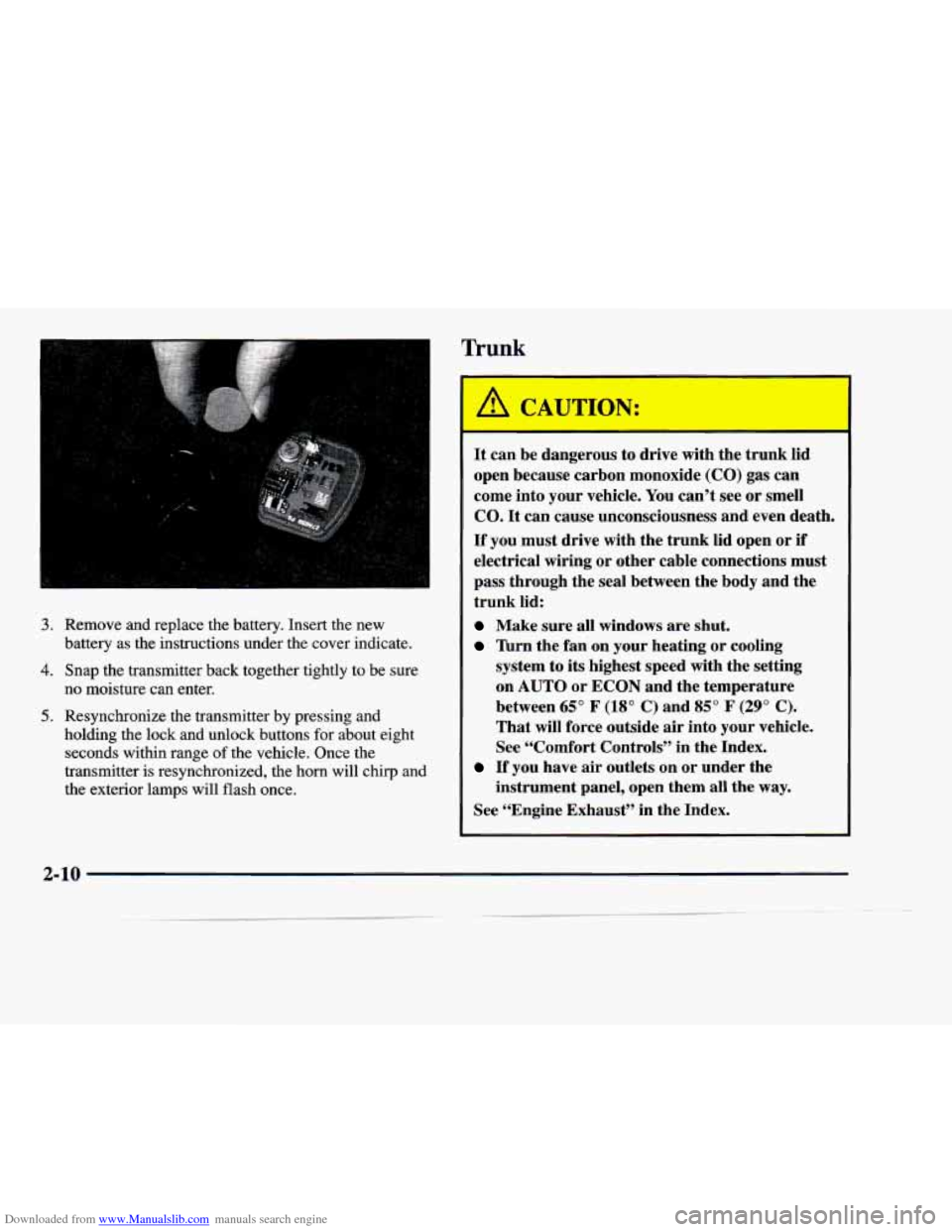
Downloaded from www.Manualslib.com manuals search engine 3. Remove and replace the battery. Insert the new
4. Snap the transmitter back together tightly to be sure
battery as the instructions under the cover indicate.
no moisture can enter.
5. Resynchronize the transmitter by pressing and
holding the lock and unlock buttons for
about eight
seconds within range of the vehicle. Once the
transmitter is resynchronized, the horn will chirp and
the exterior lamps will flash once.
Trunk
It can be dangerous to drive with the trunk lid
open because carbon monoxide
(CO) gas can
come into your vehicle. You can’t see or smell
CO. It can cause unconsciousness and even death.
If you must drive with the trunk lid open or if
electrical wiring or other cable connections must
pass through the seal between the body and the
trunk lid:
Make sure all windows are shut.
Turn the fan on your heating or cooling
system to its highest speed with the setting
on
AUTO or ECON and the temperature
between
65” F (18” C) and 85” F (29” C).
That will force outside air into your vehicle.
See “Comfort Controls” in the Index.
If you have air outlets on or under the
instrument panel, open them all the
way.
See “Engine Exhaust’’ in the Index.
2-10
Page 155 of 386
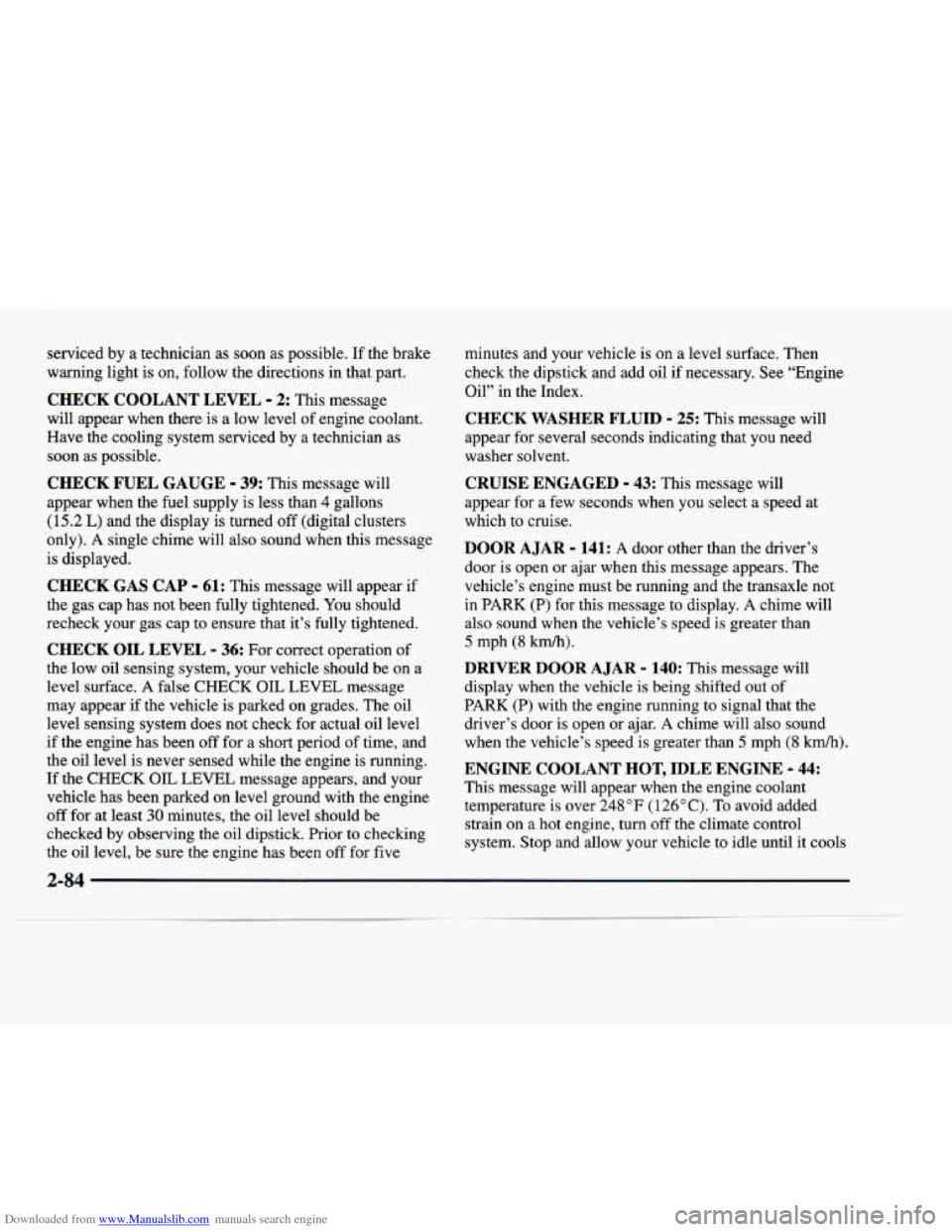
Downloaded from www.Manualslib.com manuals search engine serviced by a technician as soon as possible. If the brake
warning light is on, follow the directions in that part.
CHECK COOLANT LEVEL - 2: This message
will appear when there is a low level of engine coolant.
Have the cooling system serviced by a technician as
soon as possible.
CHECK FUEL GAUGE - 39: This message will
appear when the
fuel supply is less than 4 gallons
(15.2 L) and the display is turned off (digital clusters
only).
A single chime will also sound when this message
is displayed.
CHECK GAS CAP - 61: This message will appear if
the gas cap has not been fully tightened.
You should
recheck your gas cap to ensure that it’s fully tightened.
CHECK OIL LEVEL - 36: For correct operation of
the low oil sensing system, your vehicle should be on a
level surface. A false
CHECK OIL LEVEL message
may appear if the vehicle is parked on grades. The oil
level sensing system does not check for actual oil level
if the engine has been off for a short period of time, and
the oil level is never sensed while the engine is running.
If the
CHECK OIL LEVEL message appears, and your
vehicle has been parked on level ground with the engine
off for at least 30 minutes, the oil level should be
checked by observing the oil dipstick. Prior to checking
the oil level, be sure the engine has been
off for five minutes and your vehicle is on a level surface. Then
check the dipstick and add oil if necessary. See “Engine
Oil’’
in the Index.
CHECK WASHER FLUID - 25: This message will
appear for several seconds indicating that
you need
washer solvent.
CRUISE ENGAGED - 43: This message will
appear for a few seconds when you select a speed at
which to cruise.
DOOR A JAR - 141: A door other than the driver’s
door is open or ajar when this message appears. The
vehicle’s engine must be running and the transaxle not
in PARK (P) for this message to display. A chime will
also sound when the vehicle’s speed
is greater than
5 mph (8 km/h).
DRIVER DOOR A JAR - 140: This message will
display when the vehicle is being shifted out of
PARK (P) with the engine running to signal that the
driver’s door is open or ajar.
A chime will also sound
when the vehicle’s speed is greater than
5 mph (8 km/h).
ENGINE COOLANT HOT, IDLE ENGINE - 44:
This message will appear when the engine coolant
temperature is over
248 “F (1 26 O C). To avoid added
strain on a hot engine, turn off the climate control
system. Stop and allow your vehicle to idle until it cools
2-84
Page 169 of 386
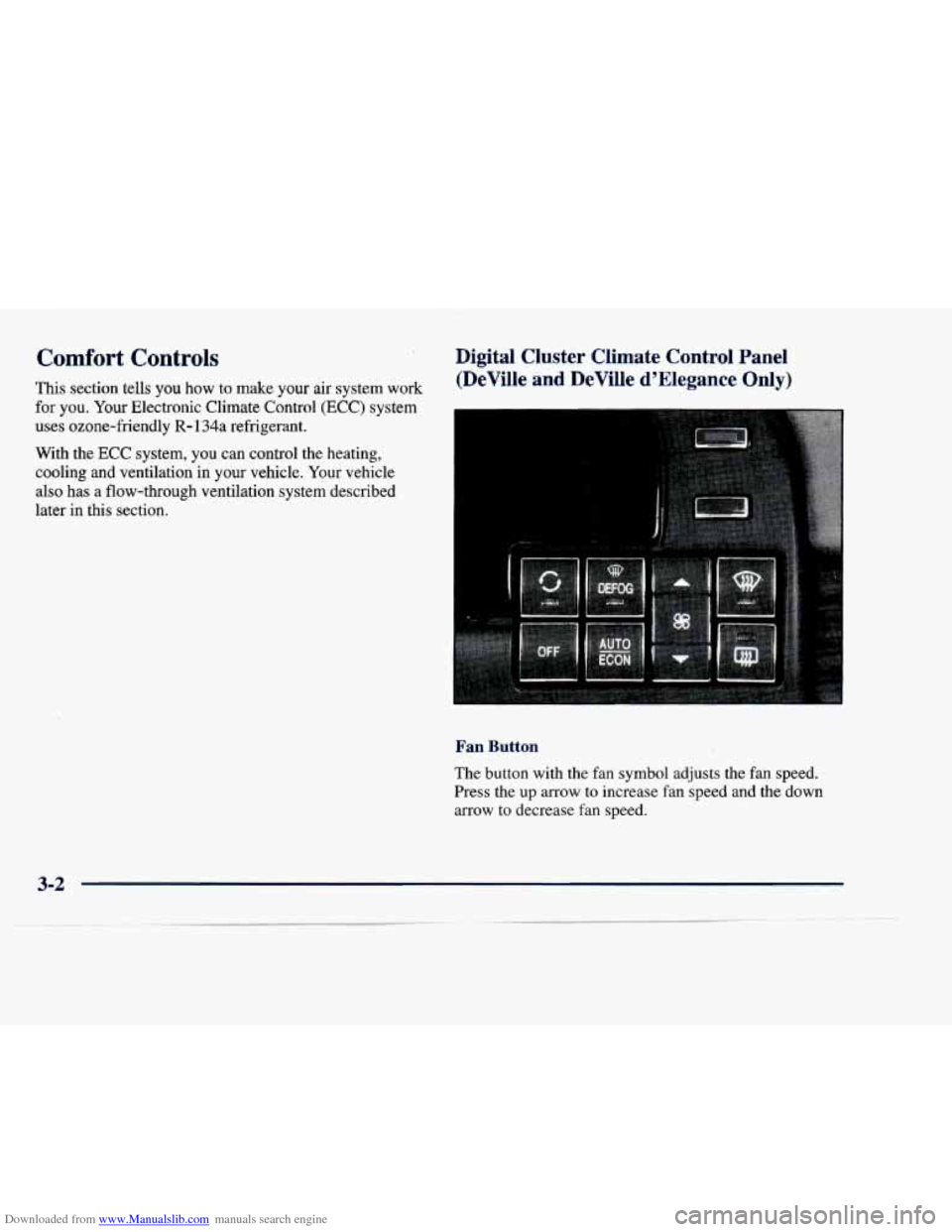
Downloaded from www.Manualslib.com manuals search engine Comfort Controls
This section tells you how to make your air system work
for you. Your Electronic Climate Control
(ECC) system
uses ozone-friendly
R- 134a refrigerant.
With the
ECC system, you can control the heating,
cooling and ventilation in your vehicle. Your vehicle
also has a flow-through ventilation system described
later in this section.
Digital Cluster Climate Control Panel (DeVille and DeVille d'Elegance
Only)
Fan Button
The button with the fan symbol adjusts the fan speed.
Press the up arrow to increase fan speed and the down
arrow to decrease fan speed.
3-2
Page 171 of 386
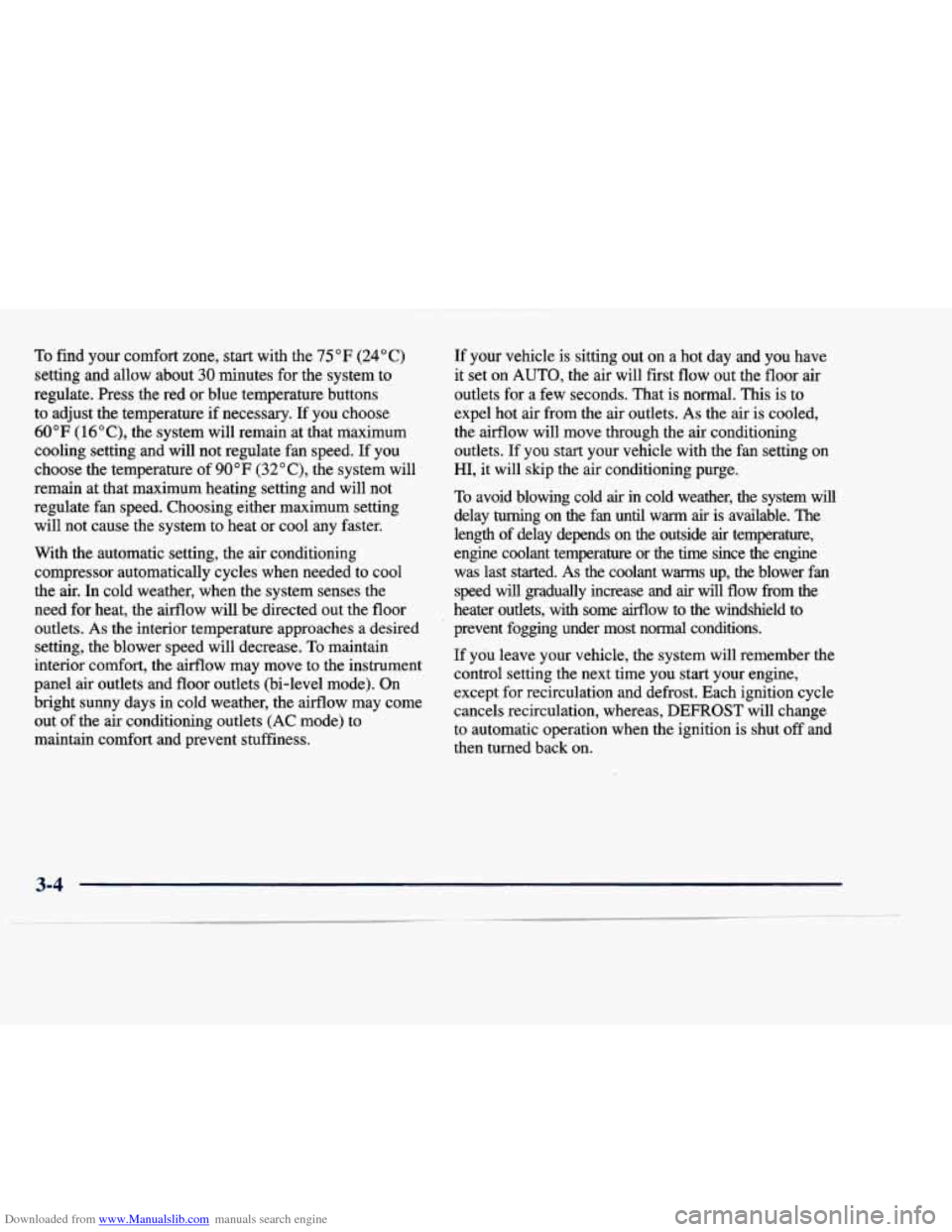
Downloaded from www.Manualslib.com manuals search engine To find your comfort zone, start with the 75 "F (24°C)
setting and allow about 30 minutes for the system to
regulate. Press the red or blue temperature buttons
to adjust the temperature if necessary. If you choose
60°F (16"C), the system will remain at that maximum
cooling setting and
will not regulate fan speed. If you
choose the temperature of
90°F (32" C), the system will
remain at that maximum heating setting and will not regulate fan speed. Choosing either maximum setting
will not cause the system to heat or cool any faster.
With the automatic setting, the air conditioning
compressor automatically cycles when needed to cool
the air. In cold weather, when the system senses the need for heat, the airflow will be directed out the floor
outlets.
As the interior temperature approaches a desired
setting, the blower speed will decrease.
To maintain
interior comfort, the airflow may move to the instrument
panel air outlets and floor outlets (bi-level mode). On
bright sunny days in cold weather, the airflow may come
out of the air conditioning outlets
(AC mode) to
maintain comfort and prevent stuffiness. If your vehicle is sitting
out on a hot day and you have
it set on
AUTO, the air will first flow out the floor air
outlets for a few seconds. That is normal.
This is to
expel hot air from the air outlets.
As the air is cooled,
the airflow will move through the air conditioning
outlets. If you start your vehicle with the
fan setting on
HI, it will
skip the air conditioning purge.
To avoid blowing cold
air in cold weather, the system will
delay turning on the fan until warm air is available. The
length of delay depends on the outside air temperature,
engine coolant temperature or the time since the engine
was last started.
As the coolant warrns up, the blower fan
speed
will gradually increase and air will flow from the
heater outlets, with some airflow to the windshield to
prevent fogging under most normal conditions.
If you leave your vehicle, the system will remember the
control setting the next time you start your engine,
except for recirculation and defrost. Each ignition cycle
cancels recirculation, whereas, DEFROST will change
to automatic operation when the ignition is shut off and
then turned back on.
Page 174 of 386
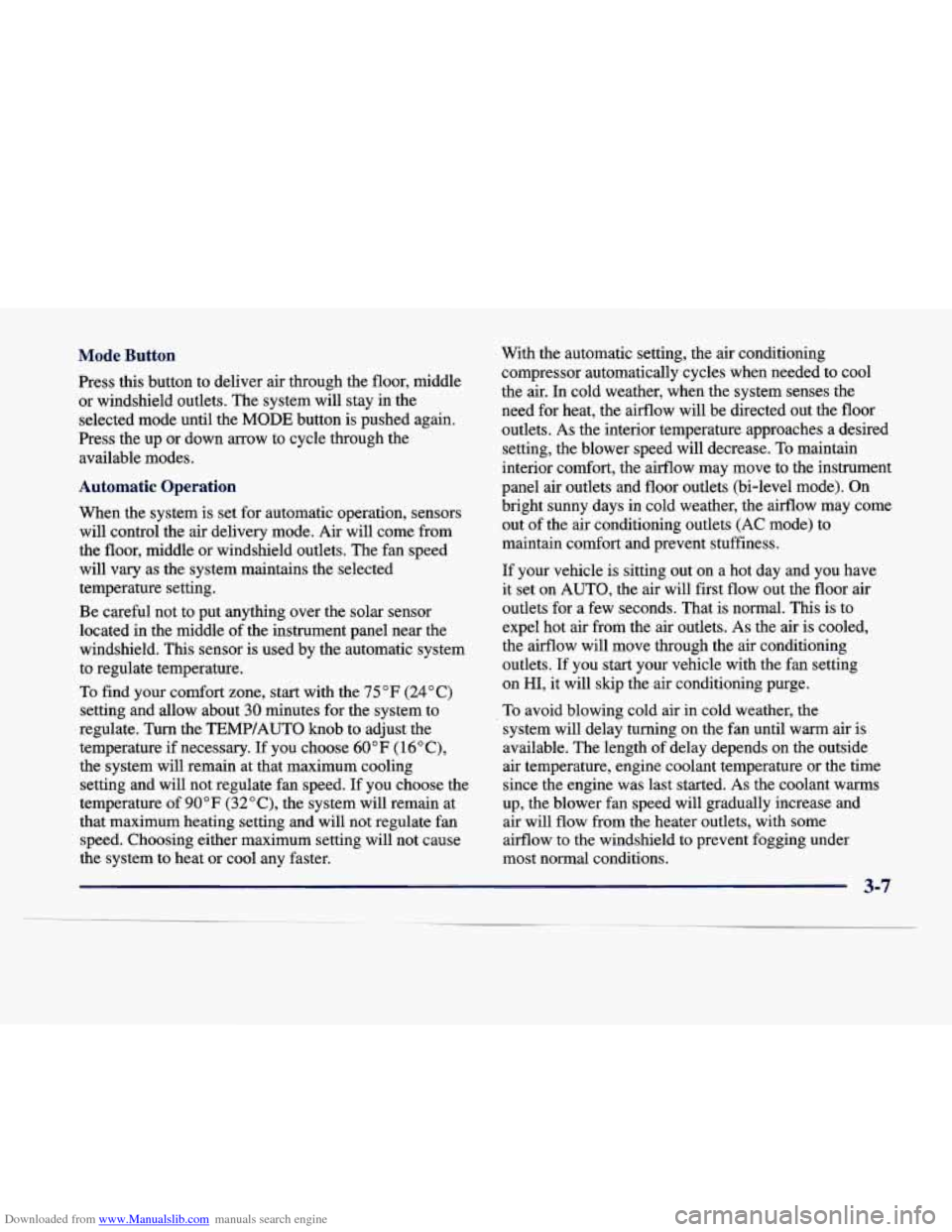
Downloaded from www.Manualslib.com manuals search engine Mode Button
Press this button to deliver air through the floor, middle
or windshield outlets. The system will stay in the
selected mode until the
MODE button is pushed again.
Press the up or down arrow to cycle through the
available modes.
Automatic Operation
When the system is set for automatic operation, sensors
will control the air delivery mode. Air will come from
the floor, middle or windshield outlets. The fan speed
will vary as the system maintains the selected
temperature setting.
Be careful not to put anything over the solar sensor
located in the middle of the instrument panel near the
windshield. This sensor is used by the automatic system
to regulate temperature.
To find your comfort zone, start with the 75°F (24°C)
setting and allow about
30 minutes for the system to
regulate. Turn the TEMP/AUTO knob to adjust the
temperature
if necessary. If you choose 60 "F (1 6 " C),
the system will remain at that maximum cooling
setting and will not regulate fan speed. If you choose the
temperature
of 90°F (32"C), the system will remain at
that maximum heating setting and will not regulate fan speed. Choosing either maximum setting will not cause
the system to heat or cool any faster. With the automatic setting, the air conditioning
compressor automatically cycles when needed to cool
the air. In cold weather, when the system senses the
need for heat, the airflow will be directed out the floor
outlets.
As the interior temperature approaches a desired
setting, the blower speed will decrease.
To maintain
interior comfort, the airflow may move to the instrument
panel
air outlets and floor outlets (bi-level mode). On
bright sunny days in cold weather, the airflow may come
out of the air conditioning outlets (AC mode) to
maintain comfort and prevent stuffiness.
If your vehicle is sitting out on a hot day and you have
it set on AUTO,
the air will first flow out the floor air
outlets for a few seconds. That is normal. This is to
expel hot air from the air outlets.
As the air is cooled,
the airflow will move through the air conditioning
outlets.
If you start your vehicle with the fan setting
on HI, it will skip the air conditioning purge.
To avoid blowing cold air in cold weather, the
system will delay turning on the fan until warm air is
available. The length of delay depends on the outside
air temperature, engine coolant temperature or the time
since the engine was last started. As the coolant warms
up, the blower fan speed will gradually increase and air will flow from the heater outlets, with some
airflow to the windshield to prevent fogging under
most normal conditions.
3-7
Page 177 of 386
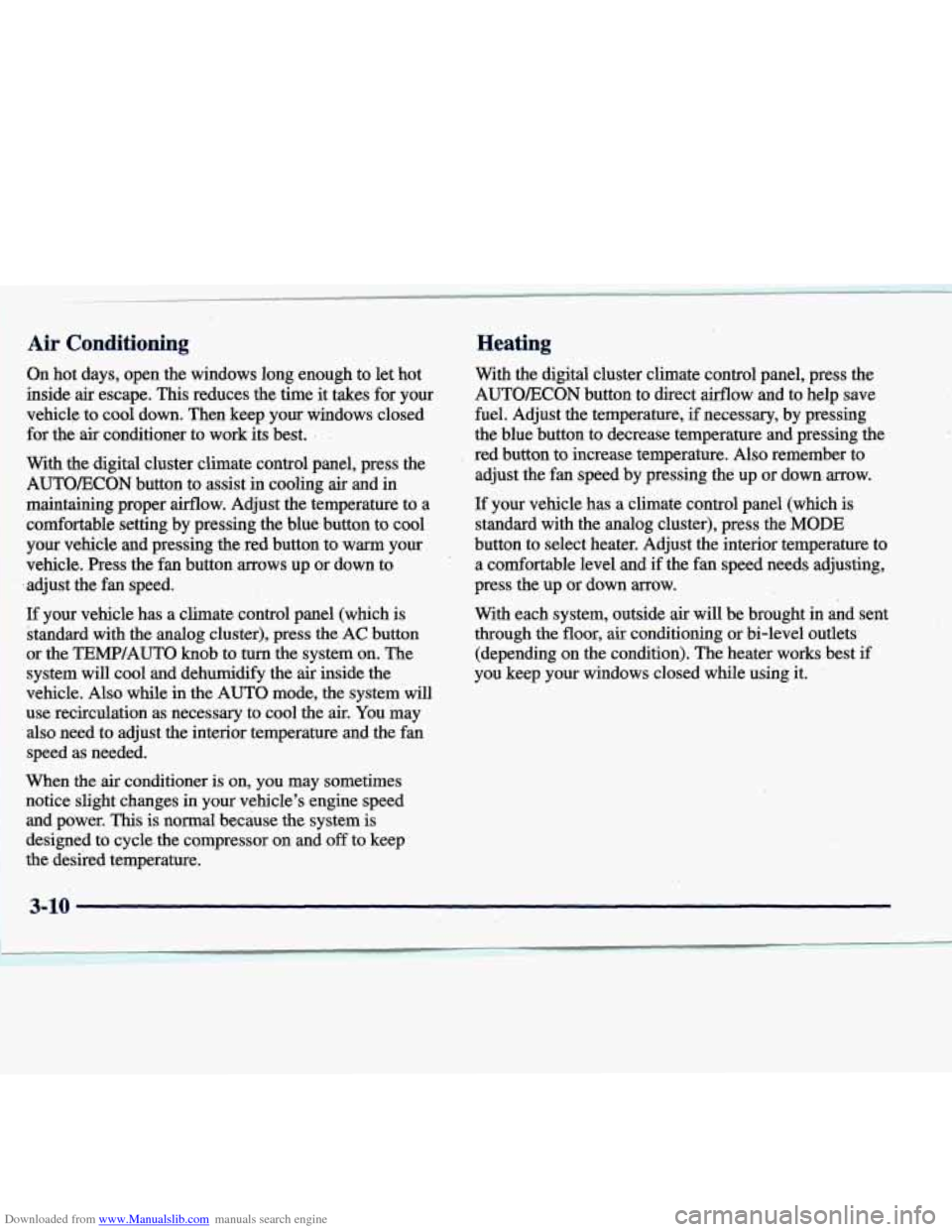
Downloaded from www.Manualslib.com manuals search engine . 3.
Air Conditioning
.On hot days, open the windows long enough to let hot
inside
air escape. This reduces the time it takes for your
vehicle to cool down. Then keep your windows closed
for the
air conditioner to work its best. I ,
With the digital cluster climate control panel, press the
AUTOLECON button to assist 'in cooling air and in
maintaining proper airflow. Adjust the temperature to a
comfortable setting by pressing the blue,button to cool
your vehicle and pressing the red button to warm your
vehicle. Press the fan button
arrows up or down to
,adjust the fan speed.
If your vehicle has a climate control panel (which is
standard with the analog cluster), press the AC button
or
the TEMPLAUTO knob to turn the system on. The
system'will cool and dehumidify the
air inside the
vehicle. Also while in the AUTO mode, the system will
use recirculation as necessary
to cool the air. You may
also need to adjust- the interior temperature and the fan
speed as needed.
When'the
air conditioner is on, you may sometimes
notice slight changes
in your vehicle's engine speed
and power. This is normal because the system is
designed to cycle the compressor
on and off to keep
the desiied temperature.
Heating
With the digital cluster climate control panel, press the
AUTOECON button to direct airflow and to help save
fuel. Adjust the temperature, if necessary, by pressing
the blue button to decrease temperature and pressing the
red button to increase temperature.
Also remember to
adjust the fan speed by pressing the up or downarrow.
If your vehicle has a climate control panel (which is
standard with the analog cluster), press the
MODE
button to select heater. Adjust the interior temperature to a comfortable level and if the fan speed needs adjusting,
press the up
or down arrow.
With each system, outside
air will be brought in and sent
through the floor, air conditioning or bi-level outlets
(depending on the condition). The heater works best
if
you keep your windows closed whiIe using it.
3-10 1 _--- -
Page 180 of 386
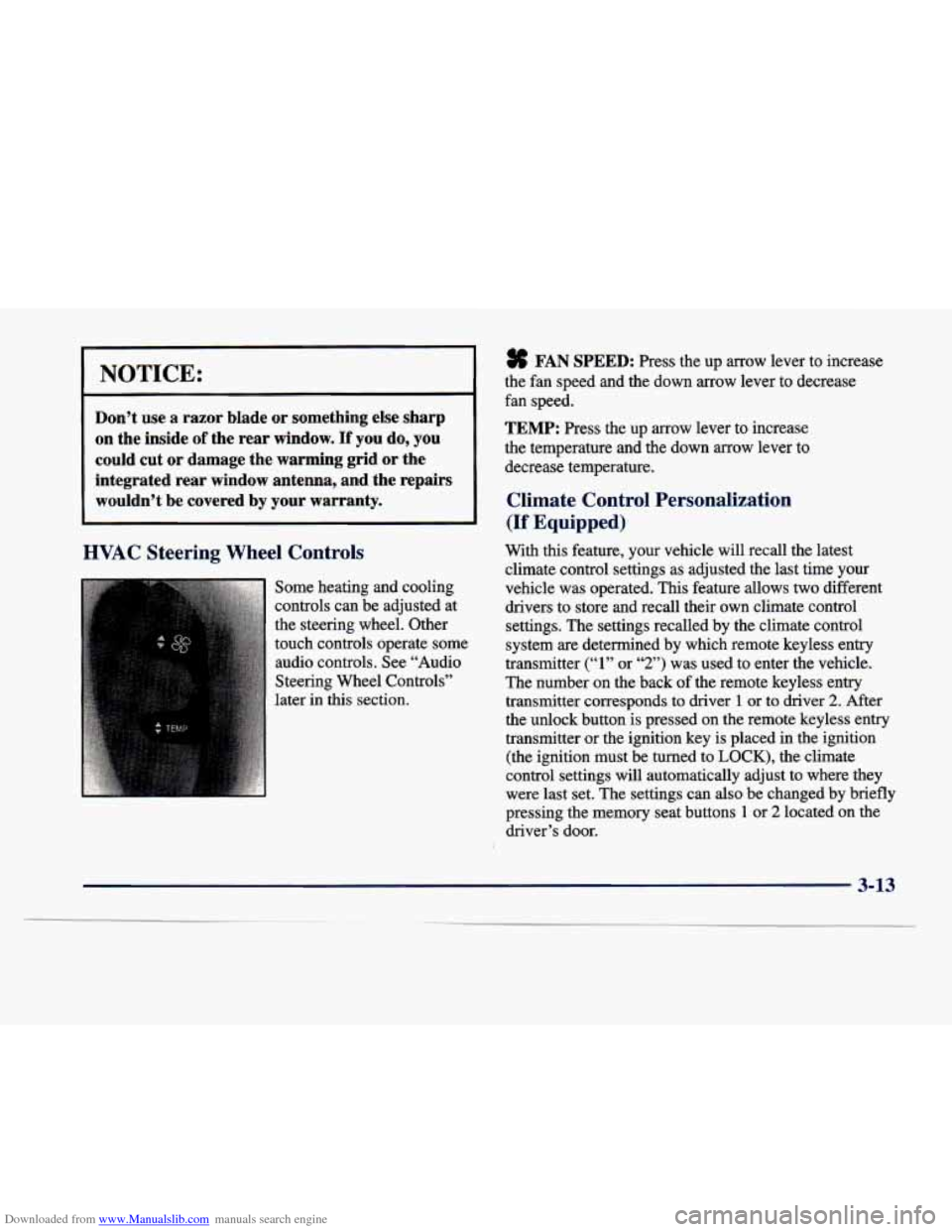
Downloaded from www.Manualslib.com manuals search engine FAN SPEED: Press the up arrow lever to increase
the fan speed and the down arrow lever to decrease
I 1 fan meed.
Don’t use a razor blade or something else sharp
on the inside of the rear window. If you do, you
could cut or damage the warming grid or the
integrated rear window antenna, and the repairs wouldn’t be covered by your warranty.
L
TEMP: Press the up arrow lever to increase
the temperature and the down arrow lever to
decrease temperature.
Climate Control Personalization
I I (If Equipped)
HVAC Steering Wheel Controls
Some heating and cooling
controls can be adjusted at
the steering wheel. Other
touch controls operate some
audio controls. See “Audio
Steering Wheel Controls”
later in this section. With
this feature, your vehicle will recall the latest
climate control settings as adjusted the last time your
vehicle was operated. This feature allows two different
drivers to store and recall their own climate control
settings. The settings recalled by the climate control
system are determined by which remote keyless entry
transmitter
(“1” or “2”) was used to enter the vehicle.
The number on the back
of the remote keyless entry
transmitter corresponds
to driver 1 or to driver 2. After
the unlock button is pressed on the remote keyless entry
transmitter or the ignition key is placed
in the ignition
(the ignition must be turned to
LOCK), the climate
control settings will automatically adjust to where they
were last set. The settings can
also be changed by briefly
pressing the memory seat buttons
1 or 2 located on the
driver’s
door.
3-13
Page 235 of 386
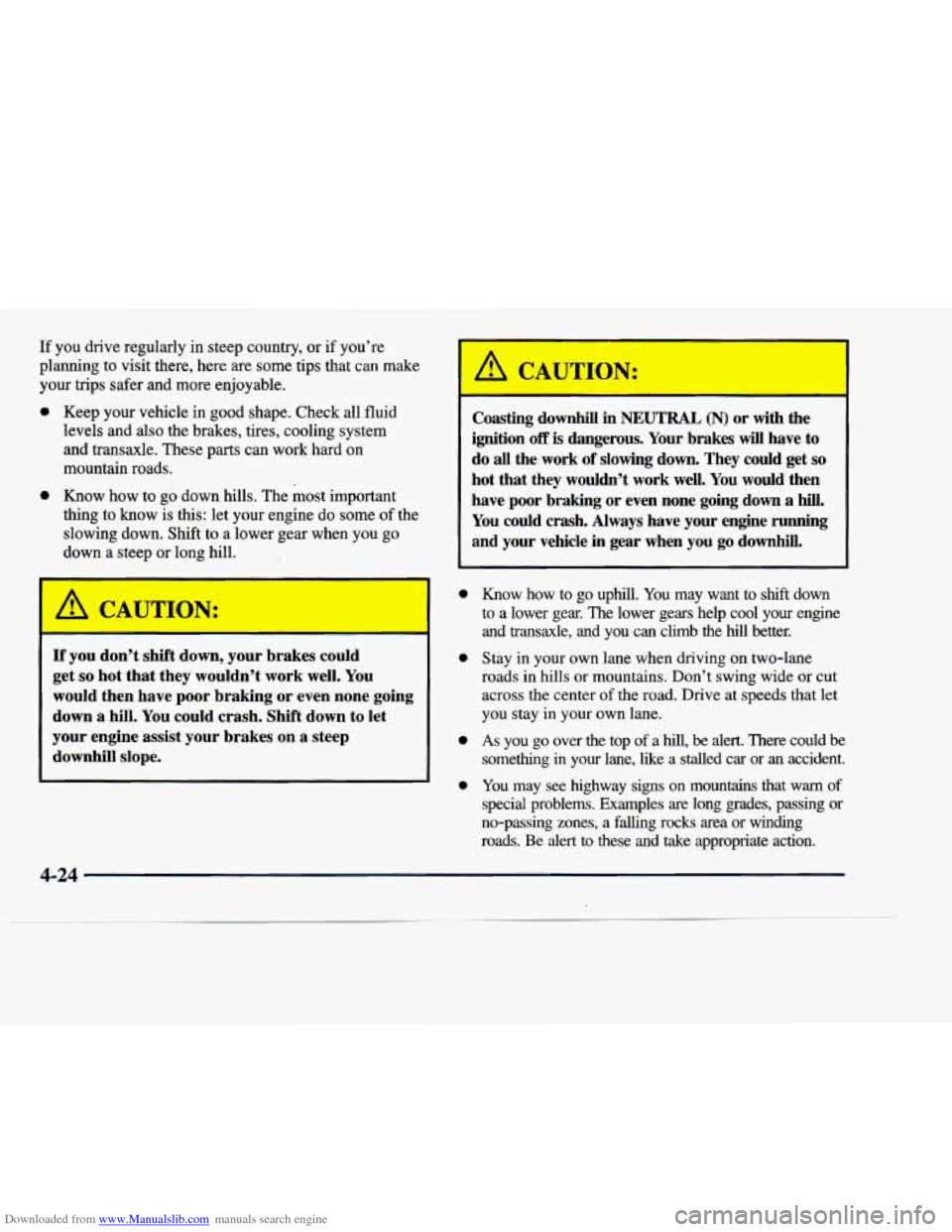
Downloaded from www.Manualslib.com manuals search engine If you drive regularly in steep country, or if you’re
planning to visit there, here are some tips that
can make
your trips safer and more enjoyable.
0 Keep your vehicle in good shape. Check all fluid
levels and
also the brakes, tires, cooling system
and transaxle. These parts can work hard on
mountain roads.
0 Know how to go down hills. The most important
thing to know is
this: let your engine do some of the
slowing down. Shift to a lower gear when you go
down
a steep or long hill.
If you don’t shift down, your brakes could
get
so hot that they wouldn’t work well. You
would then have poor braking or even none going
down
a hill. You could crash. Shift down to let
your engine assist your brakes on a steep
downhill slope. Coasting downhill
in NEUTRAL (N) or
with the
ignition
off is dangerous. Your brakes will have to
do all the work
of slowing down. They could get so
hot that they wouldn’t work well. You would then
have poor braking or even none going down
a hill.
You could crash. Always have your engine running
and your vehicle in gear when you go downhill.
Know how to go uphill. You may want to shift down 0
0
0
0
to a lower gek The lower gearshelp cool your engine
and transaxle, and you
can climb the hill better.
Stay in your own lane when driving
on two-lane
roads in hills or mountains. Don’t swing wide or cut across the center
of the road. Drive at speeds that let
you stay in your own lane.
As you go over the top of a hill, be alert. There could be
something in your lane, like a stalled
car or an accident.
You
may see highway signs on mountains that warn of
special problems. Examples are long grades, passing or
no-passing zones, a
falling rocks area or winding
roads. Be alert to these
and take appropriate action.
4-24
Page 249 of 386
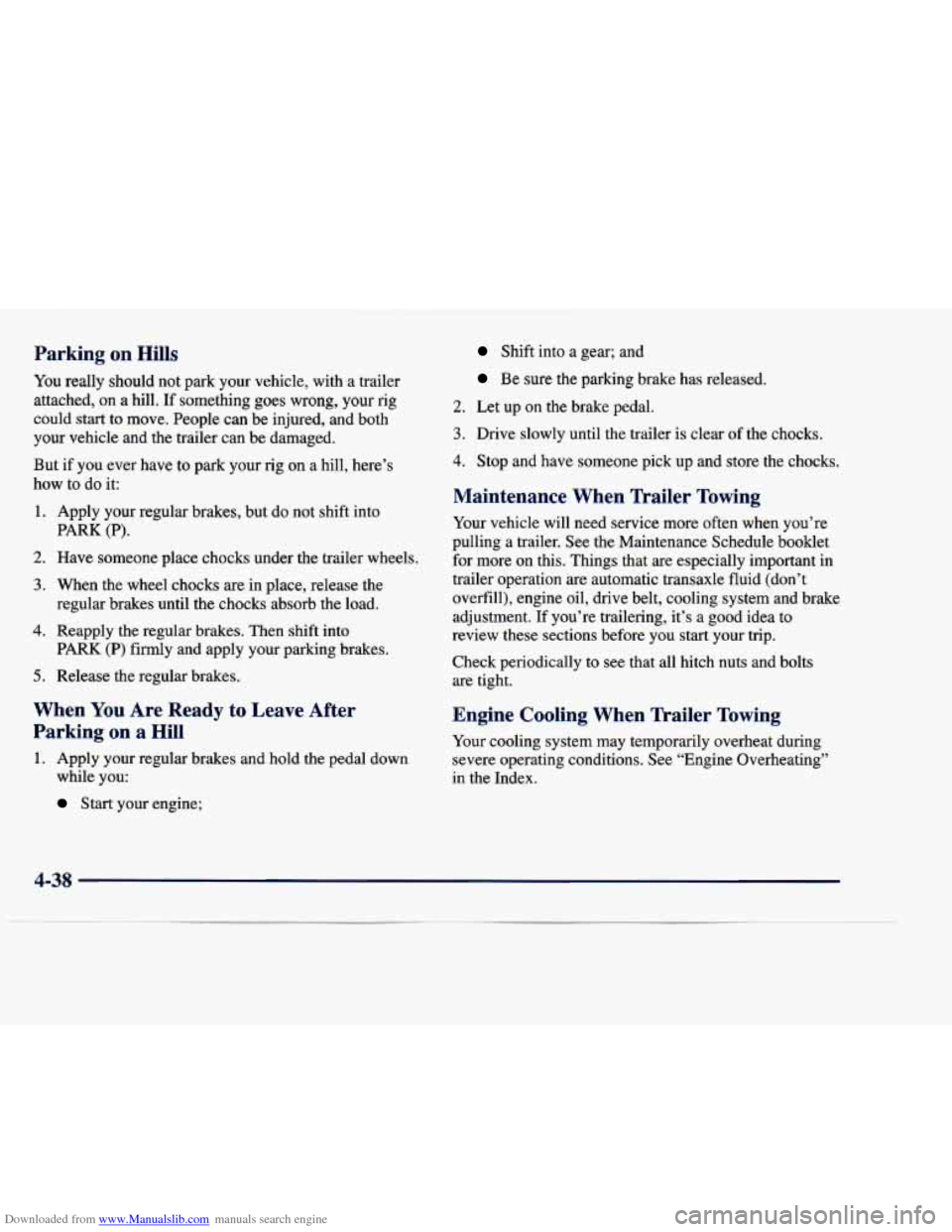
Downloaded from www.Manualslib.com manuals search engine Parking on Hills
You really should not park your vehicle, with-a trailer
attached, on a hill. If something goes wrong,
your rig
could start to move. People can be injured, and both
your vehicle and the trailer can be damaged.
But if you ever have to park your rig on a hill, here’s
how to do it:
1.
2.
3.
4.
5.
Apply your regular brakes, but do not shift into
PARK (P).
Have someone place chocks under the trailer wheels.
When the wheel chocks are in place, release the
regular brakes until the chocks absorb the load. Reapply the regular brakes. Then shift into
PARK
(P) firmly and apply your parking brakes.
Release the regular brakes.
When You Are Ready to Leave After
Parking
on a Hill
1. Apply your regular brakes and hold the pedal down
while you:
Start your engine;
Shift into a gear; and
Be sure the parking brake has released.
2. Let up on the brake pedal.
3. Drive slowly until the trailer is clear of the chocks.
4. Stop and have s‘6~1&@kt pick up and store the chocks.
Maintenance When Trailer Towing
Your vehicle will need service more often when you’re
pulling a trailer. See the Maintenance Schedule booklet
for more
on this. Things that are especially important in
trailer operation are automatic transaxle fluid (don’t overfill), engine oil, drive belt, cooling system and brake
adjustment. If you’re trailering, it’s a good idea to
review these sections before you start your trip.
Check periodically to see that all hitch nuts and bolts are tight.
Engine Cooling When Trailer Towing
Your cooling system may temporarily overheat during
severe operating conditions. See “Engine Overheating”
in the Index.
4-38
Page 267 of 386

Downloaded from www.Manualslib.com manuals search engine When you decide it’s safe to lift the hood, here’s what \
you’ll see:
A CAUTION:
An electric engine cooling fan under the hood can
start up even when the engine is not running and
can injure you. Keep hands, clothing and tools
away from any underhood electric fan.
If the coolant inside the coolant surge tank is boiling,
don’t do anything else until it cools down.
A. Coolant Surge Tank with Pressure Cap
B. Electric Engine Fans
5-18